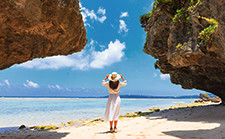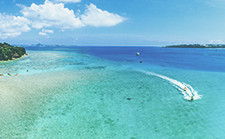CREATIVE OCEANSIDE RESORT RESPONSES TO
UNPREDICTABLE AND UNFAVORABLE
WEATHER CONDITIONS :
“WHAT TO DO WHEN IT RAINS!”
A Monograph
Presented to the Faculty of the Graduate School
of Cornell University
in Partial Fulfillment of the Requirements for the Degree of
Master of Professional Studies
by
Tony Yoshikazu Higashi
May, 1990
TABLE OF CONTENTS
CHAPTER
CHAPTER 1 : STATEMENT OF THE PROBLEM
CHAPTER 2 : INFORMATION FROM THE QUESTIONNAIRE
2.3 Results and Analysis of the SurveyCHAPTER
CHAPTER 3 : TECHNOLOGICAL ASPECTS OF THE RAINY DAY PROGRAM
3.1 Facilities and Equipment for Activities
3.2 Desired Facilities and Equipment
3.3 External Environments ofOceanside Resort Facilities
CHAPTER 4 : HUMAN ASPECTS OF THE RAINY DAY PROGRAM
4.1 Activities Supported by Human Resources
4.2 Activities based on Customer Segments
4.3.1 problem Awareness and Motivation
4.3.2 Skills Required for Rainy Day Activities
4.3.2.1 Ideal professional Skills
4.3.2.2 Skills Required for Rainy Day Activities
CHAPTER 5 : MANAGERIAL ASPECTS OF THE RAINYDAY PROGRAM
5.1 Policies for Customer Satisfaction
5.3 Strategy for the Rainy Day program
5.3.1. Strategies based on Human Resources
5.3.1.3 Efficient Staffing and Utilization of Human Resources
5.3.2 Strategies based on Facilities and Equipment
Appendix 2 Most Common Rainy Day Activities (Total)
Appendix 3a Common Rainy Day Activities (Caribbean)
Appendix 3b Common Rainy Day Activities (Hawaii)
Appendix 3c Common Rainy Day Activities (Florida)
Appendix 3d Common Rainy Day Activities (Southern California)
Appendix 3e Common Rainy Day Activities (Mexico)
Appendix 3f Common Rainy Day Activities (Guam/Saipan/0kinawa)
Appendix 4a Detailed Rainy Day Activities (Caribbean)
Appendix 4b Detailed Rainy Day Activities (Hawaii)
Appendix 4c Detailed Rainy Day Activities (Florida)
Appendix 4d Detailed Rainy Day Activities (Southern California)
Appendix 4e Detailed Rainy Day Activities (Mexico)
Appendix 4f Detailed Rainy Day Activities (Guam/Saipan/Okinawa)
Appendix 5 Most Desired Facilities and Equipment (Total)
Appendix 6 Detailed Desired Facilities and Equipment (Total)
CHAPTER 1
1. STATEMENT OF THE PROBLEM
Go into any travel agency in the world and you will find dozens of colorful brochures describing the particular attractions of hundreds of vacation and resort areas located all over the globe. The prospective traveler can choose from a nearly unlimited variety of activities and locales. He or she may choose skiing in the Swiss Alps, surfing in Hawaii, or snorkeling in Australia. Let’s say our prospective traveler has decided on an oceanside resort in the Caribbean. A quick look at the brochures shows that every oceanside resort promises sunny days, secluded beaches, playful surf, and gorgeous sunsets. But can these resorts really keep all of their “promises” to the traveler?
It would be impossible to find an advertisement in a travel magazine or an illustration in a resort brochure that even hinted that “Paradise” could be anything less than absolutely perfect. No, the world presented in the brochures is a fantasy playground of beautiful, suntanned men and women sipping exotic tropical drinks, reclining under gently waving palm trees, and running hand in hand through gently crashing surf. All of these activities are, of course, taking place under the blazing tropical sun in a cloudless blue sky. Trust the brochures, how could anything possibly go wrong?
What the brochures don’t tell the reader is that the same geographic and climactic conditions that create “Paradise”, can also contribute to a less than perfect resort experience. Most island and beach resorts are located close to or between the Tropic of Cancer and the Tropic of Capricorn, imaginary lines that circle the Earth, parallel with, and north and south of, the equator. As a rule, the weather in places located in this section of the world is sunny and warm and wet. Did you say wet? Do you mean it rains in “paradise”?
The intention of this paper is not to challenge the honesty of resort advertising, or to challenge the stereotypes and images presented in that advertising; instead, this paper intends to discuss the seemingly simple question: “What do you do when it rains?” This paper will examine and evaluate a variety of creative oceanside resort responses to adverse weather conditions.
Let’s return to our hypothetical traveler, a busy associate in a prestigious Manhattan law firm, who has chosen to spend part of her annual vacation at a Caribbean island resort. The pressures of work have recently become very intense; our hypothetical traveler is looking forward to a week of sun, sand, surf, and solitude. She is looking for, as an oceanside resort’s advertisement proclaims: “a place to put the world on hold.”
Her first day on the island is fantastic; it’s everything the brochures said it would be: “enchanting beach-front accommodations”, “lush gardens”, “fragrant tropical flowers”, “exotic swim-up pool bars”, “private beaches”, “every water-sport under the sun”, and “glittering evening parties”. Our hypothetical traveler is quite happy, and to quote from another advertisement, she feels that this is “the way the world is supposed to be”.
The following morning, our traveler wakes to the drumming of rain on the roof of her beach-front cottage. It rains all day. And the next day. And the next. The resort staff are sympathetic, but all they can do is to shrug their shoulders philosophically, as if to say, “you can’t guarantee the weather.” Our traveler is very disappointed; she thinks that if she were to buy an appliance at a store, or by mail order, and she found that her purchase was not what she expected, not the same product in the catalog, or proved to be defective, because she had a warranty, she could replace the product or have it repaired. Unfortunately, she has no way to “replace” what has proven to be a “defective” resort experience. Our traveler’s problem is that she hasn’t bought a product, she has purchased a service.
When you buy a car, a camera, or a toaster-oven, you receive a warranty: a guarantee that the product you’ve purchased will work. How often do you receive a warranty when you purchase a service? Virtually never. Yet it is here, in buying something intangible that you would presumably most want the assurance of a guarantee. (Hart, 1987)
Our hypothetical traveler’s unfortunate experience might easily be dismissed as just bad luck; it’s true that for every “unlucky” resort guest there are many more who have had the time of their lives. This is little comfort to our hypothetical traveler, her unhappy experience is all she had. So then, is the percentage of unsatisfied vacationers so insignificant that it can be conveniently ignored? My research, and my resort survey suggest that while no resort hotel would ever admit that this is indeed true, common island and seaside resort responses to adverse weather conditions reveal that providing satisfactory recreational alternatives for “unlucky” travelers has not received much attention. While it’s true that every resort has responses to bad weather, my survey of 121 ocean side resorts suggests that many of their responses might be better. But before making any suggestions, we must first turn to an analysis of the survey data.
CHAPTER 2
2 . INFORMATION FROM THE QUESTIONNAIRE
2.1. Overview
The survey process began with the creation of the survey. The chief objective of the survey questionnaire was to solicit information from resort and ocean-front hotels concerning their responses to inclement weather. The survey (conducted in the spring of 1990) asked oceanside resorts about their rainy day programs. A copy of the questionnaire form is attached (Appendix 1). The main considerations in designing the questionnaire form were: simplicity, clarity, and ease of response. It was believed that a single page questionnaire form that wouldn’t take too long to fill out, would generate the most replies. Self-addressed envelopes were attached to each questionnaire; return postage was enclosed for resorts located in the US and its territories.
The questionnaire form itself was divided into two sections. The first section established the problem: a rainy day at an ocean side resort. The resorts were asked what three activities would be provided for their guests on such a day. The form asked the resort to respond by specifying the activity, the location, and the satisfaction level of the guests who participated. The satisfaction level was evaluated numerically as: (1) very satisfying; (2) mostly satisfying; (3) satisfying; or (4) unsatisfying. Although this satisfaction level is subjective (extremely depends on the each person’s criteria), the author wanted to see each resort’s problem awareness of customer satisfaction in the rainy day program. For this reason, satisfaction levels were not analyzed statistically at all, though some of them are cited in the text to explain the situation.
2.2. Sample of the Survey
The survey sample was drawn from selected oceanside resorts located in: Florida (Miami Beach and Daytona Beach); numerous Caribbean islands; Mexico (Cancun on one coast and Acapulco on the other); Southern California (Santa Monica, Marina Del Rey, and San Diego); Hawaii; and finally, the western pacific islands of Guam, Saipan, and Okinawa.
Three factors were considered in choosing this sample. The first was that a majority of these locations are the most popular oceanside resort locations for travelers coming from North America. The second factor was that oceanside resorts in Hawaii and the western pacific islands of Guam, Saipan, and Okinawa are the most popular destinations for Japanese travelers. This survey focused mainly on the oceanside resorts most attractive to American and Japanese markets.
In selecting the survey sample, the size of the hotel property was the third determining factor. It was decided to select resort hotels with 100 or more guest rooms. One of the reasons for this decision was that it might be considered easier for the largest hotels to develop a specialized rainy day program. For example, a twenty room Caribbean hotel tends to have a warmer, more “at home” atmosphere between the hotel staff and the customers than a huge hotel. Almost everyone could participate in the rainy day activities planned by the small hotel’s staff, although its facilities might be rather limited. Activities at a smaller hotel might not have to be as varied or have to include as many people as would certainly be the case at a 100 room hotel. The large oceanside resorts have greater resources, both financial and human. Greater resources mean greater responsibilities. For the purposes of this survey, it was decided to concentrate on larger oceanside resort hotels (100 or more rooms). Also, hotels which are specializing in an all-inclusive type of service are not included because their originally entertainment-oriented programs are sometimes very different from those at traditional resorts.
The hotel names and address were gathered mainly from AAA (American Automobile Association) Tour Books for each of the selected states, territories, countries, and geographical areas except for the western Pacific islands of Guam, Saipan, and Okinawa. Information for this came from different sources. The questionnaire was sent to 355 oceanside resorts that listed hotels with more than one hundred guest rooms and with beaches located within easy walking distance. The responses and results of this survey of oceanside resorts are analyzed in the following section.
2.3. Results and Analysis of the survey
A total of 121 responses had been reviewed as of May 10, 1990. This number represents 34.1% of the total number (355) of properties selected to receive the questionnaire. Response ratios varied from area to area; some areas did not have sufficient response data to permit statistical analysis. However, the goal of this monograph was not, specifically, to analyze the collected data. The main objectives of this paper are to share information about oceanside resorts’ rainy-day programs, to increase resort managers’ awareness of the various responses to inclement weather, and finally to help contribute to providing the customer with pleasurable experiences. The author would be pleased if the information and recommendations based on the survey responses could fulfill a need for a checklist of rainy day activities or provide criteria for evaluating and improving rainy day programs.
A listing of the most common rainy day activities, tabulated from all oceanside resort responses, can be found in Appendix 2. Complete listings of each selected area’s rainy day activities are also included (Appendices 3a-3f). Categories of activities and detailed rainy day activities (Appendices 4a-4f) and where they are held, can also be found in the appended data.
It was discovered that while the ocean side resorts present an image of sophistication, and indeed, provide an extensive selection of exciting resort activities such as snorkeling, scuba-diving, tennis, horseback riding, etc., in their normal operation, resort responses to bad weather conditions reveal a much narrower range of activities. It can be said that many of the ideas are familiar to anyone who has ever tried to entertain a roomful of children on a rainy day. This comparison is not meant to demean or make fun of the hardworking resort staff responsible for rainy day programs; what the previous statement does mean to suggest is that the typical rainy day program has remained at a very simple and uncomplicated level.
A glance at the top five rainy day activities shows that the most common resort response to inclement weather was to show movies, videos, and/or television shows. The second most often listed activities were the playing of table and board games, such as Trivial Pursuit, dominoes, Scrabble and games like chess, backgammon, checkers, and cards. The third most mentioned rainy day activity was bingo. The popularity of playing bingo for prizes was popular throughout most of the Atlantic-coast resorts. Recreational games and events such as musical chairs, charades, or scavenger hunts, beer-drinking contest, and wet and wild T-shirt contests were the fourth most common rainy day activities. The fifth most mentioned rainy day activities were categorized as cultural/educational classes, such as Hawaiian hula dance lessons, flower arranging, and cooking classes.
Hardly any of the responses mentioned above were strikingly original; most of them can be considered very traditional responses to unfavorable weather conditions. Every customer service or guest recreation manager would probably come up with identical ideas. If this is the case, then the “Most Common Rainy Day Activities” table (Appendix 2) should be regarded as minimal customer/guest expectations. These listed activities are “base amenities” and cannot be determinant factors in planning resort hotel sales or marketing strategies, since the guests expect the oceanside resorts to provide at least these minimum response activities during periods of inclement weather. As Lewis (1984) has written in the Cornell Hotel and Restaurant Administration Quarterly:
For example, amenities [in] hotel bathrooms may not be determinant when all directly competing hotels have them. If the amenities are removed from one property, however, then absence may be negatively determinant, because the hotel’s features are now out of line with its competitors offerings.
The example of hotel amenities mentioned above, may be applied to the value of a rainy day program. Currently, the attractiveness or sophistication of a rainy day program is not now a major marketing attraction for potential customers. After all, no one expects bad weather when making vacation plans. The conspicuous mention of special rainy day programs might have a backlash effect. Rather than attracting more customers, some travellers may avoid that resort destination because they make the mistake of thinking that the area advertising rainy day programs must have frequent bad weather. While this may be true for some travellers, most travellers would welcome the attraction of an entertaining rainy day program. But, as the survey results suggest, the above mentioned top five rainy day activities are not strong selling points. Recommendations for developing stronger rainy day programs by utilizing resort facilities and human resources will be outlined in future chapters.
As the Appendices (3a-4f) show, oceanside resorts’ rainy day programs vary according to geographic location, nationality, or other characteristics of the resort area. Although responses differ, what is evident from the number of responses received –121, which is 34.1% of all the resort properties queried — is that 87.6% of the resorts which responded have some kind of rainy day program. Some programs are very well organized; two resorts located in Barbados and Puerto Rico had very strong programs that were well thought out. Other rainy day programs do not appear to be as well-planned, creative, or satisfying. As long as the weather is beautiful, the weakest rainy day plan is no liability. In a sense, it might be said that clear blue skies and bright sunshine make both a weak and a strong plan irrelevant. However, the resort that is well prepared for unpredictable weather has established a competitive edge against its direct competitors. The data collected and organized into the “Detailed Rainy Day Activities” tables (Appendices 4a-4b) should be a starting point for developing better resort responses to inclement weather.
The next sections will deal with the problems and conditions at specific resort areas; analysis of their responses will follow. This material is based on the survey conducted, and understood through an academic approach to the technological and human resource aspects of the rainy day program.
CHAPTER 3
3. TECHNOLOGICAL ASPECTS OF THE RAINY DAY PROGRAM
3.1. Facilities and Equipment for Activities
As was suggested at the beginning of this paper, the oceanside resort industry, like other entertainment businesses, is selling fantasy. Take the cover of Islands magazine (June 1989) as an example. Two figures, who appear to be a father and his young son, are silhouetted against a gorgeous Molokai sunset, flaming across the sky in pastel hues of apricot, salmon, lemon, and mauve. What reader couldn’t imagine himself/herself in the place of these two figures, ankle deep in gentle surf, luxuriant palms arching overhead and practically every care banished from thought? Only a few minutes of browsing through the magazine, and others like it, reveals similar advertisements of beautiful couples, hand in hand, walking on deserted beaches, as a scarlet and gold sunset sinks slowly into the blue Pacific. You bet it’s a fantasy. But fantasy, in this instance, doesn’t mean “unbelievable”.
One can’t have everything, though. Resort facilities, particularly bad weather facilities tend to be limited. But resort managers have fantasies of their own. Some of the humorous wishes of the managing staff were for a hotel submarine with a huge on-board casino and movie theatre, artificial reefs to control waves and surf, and even a fanciful request for a section of ocean with a retractable and illuminated dome-type roof! While these ideas are not completely impossible to implement with existing technology (some actually own submarines for under-water tours), considering the financial resources available to most resort hotels, the author does not recommend these capital intensive projects for only the rainy day programs, unless the Pentagon supports your budget. All kidding aside, it is important for hotel managers to have “a big dream” for their entertainment facilities. A competitive edge is always available for the imaginative and innovative.
Returning to the very real problems of oceanside resorts, facilities are critical in any evaluation or establishment of a rainy day program. 102 of our 121 respondents described the facilities and equipment desired for rainy day activities.
It’s obvious; what’s available influences what can be offered. Generally speaking, hotel facilities are capital intensive and the return on investment is slow. In addition, a resort facility, such as a multi-purpose event hall, indoor sports space, and a health club/spa requires space, as well as money. Therefore, most resort hotels find themselves using their lobby area, lounge, or banquet/ballroom for most rainy day activities. (See Appendix 2.) Since space is at a premium, it might be very wasteful, especially for locations with a proven record of few bad weather days, to create facilities exclusively for rainy day programs. For this reason, efficient utilization of the hotel’s currently existing plant is considered extremely important. If possible, it would be better to consider creating and developing, multi purpose, flexible plants from the very beginning of a planning stage.
In addition to spatial and physical plant limitations, recreational equipment is an important factor in developing a rainy day program. If integrated well with hotel facilities, portable game equipment such as ping pong tables or billiard tables can transform meeting/function rooms into extra recreational spaces. Creative use of space and equipment is essential for rainy day programs. Creativity and flexibility are perhaps more important than simply having great facilities. Creative and flexible approaches to solving “rainy day” problems are important for smaller resort hotels as well as the huge, multi-purpose resort complexes.
3.2. Desired Facilities and Equipment
Appendix 5 shows the desired facilities listed by the resort hotels who responded to the questionnaire. The survey asked hotel to list anything they would like to add to their rainy day programs. Most hotels (102 out of 121, 84.3%) want to upgrade the facilities and equipment.
By far the most requested item was a movie room. This request was, substantially, a desire for as complete a movie theater as possible. This request agrees perfectly with the most common rainy day activity — movies. The desirability of a large screen, “up-scale theater”, and hi-tech movie and video equipment was frequently mentioned. It is only a guess, but the details included in this most requested of facilities/equipment leads one to think that although showing movies is the most common activity in the rainy day program, the quality of the equipment and the comfort/appropriateness of the location may not be the best. One hopes that resort staff are trying to improve on the simple video-cassette recorder and television monitor.
The second most desired facility was an indoor sports court. This excludes a gym/health club which is a separately ranked request. Indoor courts for tennis, basketball, and volleyball were highly sought after. This facility was mentioned nearly as often as the movie/video facility, with 24 responses desiring an indoor sports court to 27 responses who expresses a need for the movie room.
A game room, supplied with video and computer games, or place for playing card and board games, was the third most requested facility.
The next facility requested was a gym/health club. Among them, many of the properties requested spa functions and exercise equipment.
Indoor pool is the fifth most desired facility. Not only swimming pools but other types of patio pools and whirlpoo1 baths were mentioned. These would be good resources or alternate locations for beachside games, water-fun sports and limited snorkeling and diving lessons.
It should also be noted that a recreation activity room shares fifth place with the indoor pool; this facility is seen as an event hall or community center.
The last three (ranked seventh) are a casino, including a particular facility and equipment, a library or “cozy room” for quiet reading/study; and finally a pool/billiard room space with several tables as well as a pool bar.
3.3. Externa1 Environments of Oceanside Resort Facilities
External environments greatly influence the resort hotel’s facility management. For instance, a location with easy access to a city, despite being an ocean side resort, means that you are able to draw on a much larger “reserve” of potential rainy day program activities. A resort hotel might provide transportation, on bad weather days, to local movie theaters. The availability of commercial cinemas reduces the need for “in-house” movies or movie rooms. The availability of shopping malls, antique shops, or souvenir shops allows the guests to enjoy themselves without extensive efforts on the part of the hotel staff. The presence of historical places, museums or other cultural centers, such as concert halls and play houses, adds inestimable resources to such a resort’s rainy day program. Honolulu, Hawaii, appears to be fortunate in having these options available. In Honolulu itself, the number one rainy day activity is shopping, followed by museum, aquarium, and city tours. Movies rank a distant third. It isn’t surprising then, that 6 out 14 respondents claim to have “no rainy day program at all”. While it is risky to make assumptions based on such a small statistical sample, it is common sense to say that the value of a rainy day program increases the farther one is away from the entertainment resources of a large city. The rainy day program should be important for oceanside resorts in secluded locations or relatively undeveloped, non-urban islands.
CHAPTER 4
4.HUMAN ASPECTS OF THE RAINY DAY PROGRAM
While facilities and equipment are very important for effective rainy day programs, any program, no matter how limited or unlimited it is with regard to facilities or equipment, benefits from great human resources. At the heart of the rainy day program, as well as regular resort activities, are staff members and line employees. Their creativity, innovation, and operational skill “make or break” the total resort experience. In this Chapter, human aspects of rainy day activities are described in order to explain their importance.
4.1. Activities Supported by Human Resources
As just mentioned, even the best of facilities, or the most desirable, such as an in-house theater or an indoor sports center are less effective unless they are incorporated into well organized programs. Programs are, of course, the creation of human intuitiveness and intellect. This paper asserts that human resources are the most precious elements in any resort’s entertainment plan.
In this section, some creative concepts for the rainy day program, based mainly on the survey’s information, will be discussed. (Common activities have already been mentioned in Chapter 2; details are listed in the appended tables.)
Most resort properties offer special activities for their guests during rainy days or bad weather conditions. However, the resorts may be divided into two general categories. What separates these two groups is the motivation and response evident in their differing response to adverse weather. “A” class oceanside resorts may be considered as those for whom a rainy day program is a carefully designed and implemented alternate program of guest entertainment. The other kind of resort, the “B” class resort, also has a response to inclement weather. However, this “B” class organization has made the mistake of viewing the occurrence of unfavorable weather as an occasion calling for “stop-gap” or temporary measures. Rather than developing an aggressive program of alternate entertainment, this class “B” class resort contents itself with card or board games during periods of bad weather. Even if it could be argued that financial constraints limit rainy day responses to minimal activities, creative staff will find innovative, or revitalize ordinary hotel procedures that might, in themselves, become ways of involving guests, and taking their minds off the inclement weather.
Some resorts have done exactly this and implemented the hotel’s routine operations as part of a rainy day program. For example, certain ocean side resorts offer cooking demonstrations conducted by staff chefs. The bar-tending staff offer “mixology” classes. These may not seem to be very original responses; they are, however, easy to implement, with staff approval, and do divert the guests. One should not minimize the appeal of activities of this nature; a certain glamour is still attached to the preparation of food and beverages at resort hotels. The staff for these jobs are often regarded as “artists” rather than mere employees. The popularity of cooking shows testifies to the great appeal preparing (and consuming) food has for many people. Special hotel recipes, or unique foods might be popular attractions.
Even the most trivial activity can be surprisingly satisfying. One resort reported that, for a rainy day activity, they offered oyster opening lessons and a napkin folding class. While not all the participants were extremely satisfied, many did find it a pleasant diversion during the bad weather conditions.
It would be unwise to expect that these simple and limited activities would ever become a major part of any resort’s repertoire of rainy day entertainment, but something positive is much, much better than nothing. In a small way, the oyster opening and napkin folding class demonstrates the first step in developing a rainy day program: efficiently utilizing the existing resources. The second step follows the first: consider what facilities equipment and staff would be needed to offer a better, and more satisfying, rainy day program that would reinforce the particular resort’s attractiveness and provide a competitive edge against primary competitors.
4.2. Activities based on Customer Segments
The ideal attitude toward the rainy day program has been outlined in the previous section. However, before planning a rainy day program, it is important to study the characteristics of one’s guests and to position activities in order to have them accepted by the guests. Each resort contains different market segments which implies that an excellent rainy day activity at one property may not always work well in another location. Even in the same property, the customers themselves, probably reflect several different segments. The size of each customer segment is also affected by the season, by the week, or even by the day. For this reason, it is recommended that the hotel gather enough information about the guests and study their characteristics in order to quickly judge what rainy day activities are best suited to the range of participants on the specific day. Flexibility and prompt action are always appreciated by resort hotel guests.
Even though staff members are especially busy under adverse weather conditions, it might be better, if the following criteria for judgement were considered before deciding what to offer:
(1) how they [hotel guest, in this case] spend their time;
(2) their interests, what they place importance on in their immediate surroundings;
(3) their opinions in terms of their view of themselves and the world around them; and
(4) some basic characteristics such as their stage in life cycle, income, education, and where they live.
The basic premise of life style research is that the more you know and understand about your customers, the more effectively you can communicate and market them. (Plummer, 1974)
A quick review of the items above might help a resort manager judge what rainy day activities should be emphasized on what day. Paying attention to these thing during routine operations, might reduce decisions to common sense deductions. For example a clientele of young single adult men might enjoy beer drinking contests, or wet and wild T-shirt contests (although not always) more than other market segments. Senior citizens would probably not enjoy Nintendo computer games as much as other recreational activities. The idea is to match the activities to the participants, but remain flexible enough to provide alternate activities for different market segments. Once again the importance of the human factors in correct decision making and implementation is self-evident.
4.3. Human Resources
4.3.1. Problem Awareness and Motivation
Creativity in designing and implementing a rainy day program is heavily dependent on excellent human resources. The success of even the best ideas is not guaranteed; the burden of “making things happen” falls on the shoulders of staff members at oceanside resorts. Motivated employees bring innovative ideas to a rainy day program and help smooth the way for their possible success. Mr. David W. Somerville, Director of Sales for Divi Resorts, Ithaca, New York (personal communication, April 10, 1990), described this type of person:
We definitely need a person who generates fun and excitement [during inclement weather] instead of joining the customers watching the rain pour down. If you have this kind of self-motivated, energetic staff person at your resort property, you’ll have no problems. But if you don’t, you’ll receive a lot of complaints. Positive customer letters usually single out that person and say something like, “even though it was raining, so and so involved us in an activity; it was fun, we has a great time and so on.
Somerville added: “this effect really depends on his/her own personality.” People who love to communicate and share fun experiences with others can be good organizers for a rainy day program. In contrast to them, people who work hard but lack that charisma or knack for interacting with the public, might fail through no real fault of their own. In such a situation. match the resource to the task.
Another important issue is “problem awareness”. Mr.Somerville also commented on this ability:
Under bad weather conditions, people [resort staff/employees] should realize that their guests are paying money for a satisfying resort experience. If bad weather continues for three or four days, and they are not satisfied with alternate activities, they must feel like they are being cheated.
All new inventions are born from problem awareness. Unless oceanside resort staff take inclement weather problems seriously, they cannot come up with any ideas or solutions to the problem. Besides this awareness, self-motivation and a positive outlook are essential for the success of rainy day activities at any ocean side resort. Human resources management policies, which are described later, can do much to generate confidence and motivation which will pay off in the rainy day program, as well as other resort operations.
4.3.2. Skills Required for Rainy Day Activities
4.3.2.1. Ideal Professional Skills
Creative managers and employees initiate and implement innovative ideas for rainy day programs. When implementing those creative ideas, it is not always sufficient just to have self-motivated people; it is often necessary to employ well-trained and talented individuals.
For example, some survey respondents desired to have a professional coordinator and/or MC (Master of Ceremonies) for the rainy day program. This makes sense. If the professional coordinator is intimately involved in every aspect of the program, perhaps even the board games will be organized with more flair or gusto. The appeal of bingo, the third most common rainy day activity, would be enhanced greatly by the presence of a professional MC who makes an ordinary game much more special through his/her interaction with participants. In general, they are also extremely familiar with the latest activities in the world. After all, the job suggests that such MCs and coordinators are entertainment professionals with special expertise in their fields.
However, this discussion of entertainment professionals must conclude with the realization that hiring, or even finding, such a person is an expensive and time-consuming task. To consider employing these professionals for the sake of the rainy day program alone is a luxury that only the wealthiest resorts might afford. Therefore, it is recommended that oceanside resorts hire and develop key employees who would be trained as entertainment para-professionals.
4.3.2.2. Skills Required for Rainy Day Activities
As described in the previous section, the hotel’s entertainment staff should be well-informed on the latest recreational activities, games, and other entertainment possibilities, because the guests at the oceanside resort are usually quite sophisticated and familiar with the latest trends in fashion, sports, and recreational activities. As a result, it is important for resorts to update their entertainment continually so that they meet or exceed customer expectations. Younger generations of resort guests are especially sensitive to entertainment trends. For example, among children, the popularity of a video/computer game such as Nintendo, is currently a worldwide phenomenon; resort hoteliers who want to keep up, must install the latest in video/computer games to maintain a competitive stance, even among school children.
Some of the all-inclusive type of resorts already have a well organized training system for the employee as an entertaining staff member. Mr. Rod Frankel, Direct of Human Resources in Club Med, Inc., of New York, NY (personal communication, March 25, 1989), mentioned in an interview conducted by the author, that:
We have a program for entertainment. This is one [process] which takes a little bit longer time [period] because entertainment in the Club can become a sensitive issue. We don’t want to hurt anyone’s feelings by making jokes or statements that are not acceptable by a particular culture, age group, or nationality. As a result, for the entertainers in the Club, we generally place them in the village as what we call overbooked staffing, or an over-staffed position. In that way the new entertainer can apprentice or work with the current entertainer for perhaps the entire season, or maybe just half a season. After the allotted time we transfer entertainers to different villages. So, in this way, they actually get a very, very long time of on-the-job training.
Indeed, Club Med has one of the most intensive and ideal training systems for developing semi-professional entertainers. The company is large enough, and successful enough, to provide a regular training program for entertainment staff. The Club Med Village and GO (Gentils Organisateurs: congenial hosts) system attracts many talented young people. Recruiters are able to apply high quality standards.
But not all oceanside resorts are able to follow Club Med’s lead in developing talented employees, and, in fact, they do not always have to do so. The size of the resort property, affiliation, or financial resources sometimes do not permit having a semi-professional entertainer or organizer within the organization. Alternative solutions may have to be implemented, but the difference that staff-members professional level skills can make in customer satisfaction with rainy day programs cannot be underestimated.
CHAPTER 5
5.MANAGERIAL ASPECTS OF THE RAINY DAY PROGRAM
5.1. POLICIES FOR CUSTOMER SATISFACION
Let’s return to the hypothetical traveler introduced at the beginning of this paper. As briefly mentioned before, our traveler decided to take a week off from the stress of her busy law practice. She had never been to the Caribbean; the idea of a week at a sunny ocean side resort seemed the perfect escape from New York’s gray spring gloom. With this in mind, she began picking up brochures and flyers at travel agencies. The resort brochures were very colorful, descriptive, and promised an amazing range of outdoor and marine activities. A certain resort’s vacation guide made an especially strong impression. The images of young, suntanned men and women on jet-skies and windsurfing boards were very attractive; the brochure promised unlimited fun in a beautiful oceanside setting. She was sold on the idea of a week spent in such an exciting manner; she bought her tickets and made the necessary arrangements.
Her first day was everything she had hoped it would be. But the following morning, she awake to the sound of a tropical downpour. Thinking it a temporary inconvenience, she turned over in bed and decided to sleep late. The rain continued to fall. By mid-afternoon, she had to abandon her windsurfing plans. Looking for alternate activities, she went down to the lobby lounge. Not much happening there, mostly unhappy people staring at the steady rain. The front desk personnel offered sympathetic words but acknowledged that the weather was beyond anyone’s control.
By the second day of steady rain, our traveler was rather depressed. Half of her vacation time gone and not much to show for it. Her visits to the lobby and frontdesk became more infrequent and ceased when she saw that, apart from a few informal card games, TV movies and free rounds of drinks at the bar, no organized rainy day activities were being offered to the disgruntled clientele.
She compared her view from her window with her imagination’s memories of the sun, sand, and surf promised in the resort brochures. The inclement weather had turned what seemed a veritable paradise into just another gloomy, grey New York spring. She imagined confronting the hotel service manager:
“Do you know The First Law of Service? ” she asked the service manager who remained silent. She quickly responded to her own question:
“The First Law of Service is expressed by the formula : Satisfaction equals perception minus expectation.
(Mister, 1985)” She continued, “I expected blue skies, golden sands, crashing surf, sea breezes, fiery sunsets, etc.
I thought I would have the time of my life.”
The manager blurted out, “Yes, madam. I feel badly that you are disappointed with the weather, but that is, of course, beyond our contro1.”
“I am not saying that the rain is your fault,” she said. “But I had great expectations for my resort experience and those have been developed by you! Your company! Even though it’s raining, I still think you are responsible for my overall resort experience. You are responsible for that!”
“Responsible? Responsible for the rain?” sputtered the service manager. “Responsible? Responsible for what?”
Although it’s only a fiction, this scenario is meant to illustrate the frustration customers feel if the weather remains bad and there isn’t an adequate rainy day program. The story was created to express the common situation of a resort guest’s very high expectations being frustrated by bad weather and non-existent, or very limited rainy day activities. Customers do arrive with high expectations; it is, undesirably, the resort’s responsibility to fulfill as many of these expectations as possible. After all, most of the guests’ impressions of what they have paid for have been created by the oceanside resort’s own advertising. This sense of responsibility for satisfying customer expectations is a part of the hotel/oceanside resort’s self-perception as not only a hotel located at the beach, but rather, a combination of the hospitality industry with the entertainment business. This idea is explored in the following section on what an oceanside resort should perceive as its mission.
5.2. MISSION:
Hollywood barely escaped being totally ravished by television. Actually, all the established film companies went through drastic reorganizations. Some simply disappeared. All of them got into trouble not because of TV’s inroads, but because of their own myopia. As with the railroads, Hollywood defined its business incorrectly. It thought it was in the movie business when it was a actually in the entertainment business. (Levitt, 1964)
This mistake can be easily made by the resort business. The ocean side resorts should not be regarded simply as hotels located at the oceanside. As entertainment complexes, the objective of the oceanside resorts should be to provide their customers with a fantastic and unique experience which they (the customers), would not otherwise be able to experience apart from the oceanside resort. If this is best achieved by marine activities in which the oceanside resort specializes, it is ideal. However, even if it rains and the resorts cannot offer the proper marine activities, their goal should still be to offer customers a rewarding and pleasant time during their vacation stay.
There are some difficulties in oceanside resort operations. Problems of seasonality or problems with equipment breakdowns do happen. A rainy day program must also face these possibilities of irregular operations. If the company has a certain goal to achieve, a goal which is clear and understandable to all employees, it will hardly be lost. For example, if your company set a “Service Guarantee” or “Satisfaction Guarantee Even During The Rain” as your business goal, it would be effective to make all employees aware of the mission of the company. Hart (1987) describes:
A service guarantee forces all members of an organization to focus on specific, customer-driven goals.
A specific, unambiguous service guarantee that is easy for employees to understand and that can be easily communicated throughout an organization enables all employees to know what the company stands for and what their role is. (Hart, 1987)
5.3. STRATEGY FOR THE RAINY DAY PROGRAM
5.3.1. Strategies based on Human Resources
Strategies that take human aspects into account can be among the most efficient and effective preparations for developing an excellent rainy day program. The author would like to develop the following brief procedures, based on the thumb rules in the hospitality industry. A brief listing of these strategies follows:
5.3.1.1. Recruiting
Recruiting the appropriate people is important in the oceanside resort.
The famous hotelier, Ellsworth Statler, recognized the problem of finding guest-oriented employees, decades ago. He advised his managers to “hire only good- natured people. ” Indeed, one of the ways to ensure a service- oriented staff is to select people who are guest oriented in the first place. (Jones & Decotiis, 1986)
It is important to hire people who can sincerely, not logically or dutifully, understand what it is customers have paid for and what they want and need from an oceanside resort. These self-motivated and people-oriented employees form the first step in a successful hotel organization.
5.3.1.2. Education
The second step is creating awareness of customer problems. The company must make its mission or corporate objectives clear to all of its employees. As mentioned before, the oceanside resort’s basic objective is to provide the guests with the best possible time. The awareness that the hotel/resort and its staff are in this kind of entertainment-oriented hospitality business, regardless of sunshine or showers, is an aspect that must be clear to all. This perception should convince members of the organization to focus on specific, customer-driven goals. (Hart, 1987)
After understanding the concept, the staff members should prepare certain skills or procedures for the rainy day program. The resort company must try to have well-trained staff who can play important roles in rainy day programs and who are committed to the objectives of the oceanside resort.
Both technical skills and interactive skills are important. As mentioned before, for the specific staff members, such as entertainers, MCs, and aerobics instructors, technical skills are definitely required. However, at the same time, they are required to have interactive skills to facilitate the rainy day program. Norman (1984) described these interactive skill in the service industry.
But there is more to education than mere technicalities. It is especially important in service operations, where the moment of truth necessary implies a great deal of uncertainty and where situations are difficult to program completely, that employees are also taught various interactive skills.
The rainy day program is definitely one of the uncertain irregular operations in the oceanside resort. He also described how to prepare for the unexpected situations, using airlines’ cabin training:
Many airlines provide their cabin staff with training in transactional analysis, to help them to cope with difficult demanding clients in unexpected situations. Many companies also use role play, creativity techniques, and conflict simulation as educational tools.
Those educational programs must help the resort hotels to operate the rainy day activities in a smooth way.
5.3.1.3. Efficient Staffing and Utilization of Human Resources
Since the rainy day program is an “irregular” program, utilizing human resources effectively and efficiently is very important. Having to increase to labor force for rainy days may prove to be impossible; therefore, a flexible organizational structure that permits “double-duty” personnel who can contribute in more than one area, may prove of the utmost importance.
5.3.2. Strategies based on Facilities and Equipment
102 of the 121 oceanside resorts (84.3%) that responded to the questionnaire stress the connection between facilities and equipment in planning and presenting rainy day activities. The presence or lack of adequate facilities/equipment is, of course, a very great factor in satisfying guests during periods of inclement weather. A common sense deduction would be that a property that has entertainment facilities sufficient to include all the hotel guests is in the best position to respond to the scheduling and organizing problems in the implementation of a rainy day program. However, only a few huge resort complexes suggested that they had enough facilities to entertain customers during sustained periods of bad weather. Although many of respondents feel that an especially designed and implemented rainy day program is an “extra”, the author believes that such a program is more than just a response to the unavailability (due to bad weather) of marine or beach activities. The rainy day program is often perceived, correctly, by the customer as a sign of the oceanside resort’s continuing commitment to providing the best entertainment possible.
Some details on equipment should be mentioned briefly. Unlike facilities, which tend to be huge labor and capital intensive projects, equipment purchases would probably be easier in terns of finances and staffing considerations. The self-contained nature of some equipment such as electronic dart boards or pool tables, entertains guests with little required supervision. Existing equipment could be upgraded. Games of bingo (very common in the Atlantic areas) might be improved by the introduction of electronic scoring devices. More sophisticated “presentation” would elevate bingo to a more exciting level. Efficient utilization of existing facilities and equipment is the first step in developing rainy day activities.
5.3.3. Other Strategies
Mention should be made of other responses to bad weather that fall outside of only providing alternate activities. This is the possibility of rescheduling or relocating customers in particular situations that can be predicted ahead of time. Mr Somerville, Director of Sales, Divi Resorts (personal communication, April 10, 1990), spoke about this possibility:
On certain occasions we have knowledge about extreme bad-weather conditions, such as hurricanes [Caribbean islands]. Three days before the hurricane actually hits an island, we have an idea about that possibility and can start to make changes. We are able to contact that island’s hotel guests and other guests, ready to travel from the US, to explain the situation. We don’t want to put them on the island if we expect the hurricane to hit; that would not be consistent with trying to guarantee positive experiences for our guests. We are willing to reschedule the customer’s destination, and vacation plans without any additional charge. We may not make as much money and may lose revenue; however, as a marketing strategy, this is a good chance to get repeat business for the future. In fact, we do get a lot of positive responses from customers who have benefitted from this policy.
Somerville added, “We are fortunate in that we are a company that has a lot of hotels in a lot of places. Customers are sensitive about weather conditions and already have received information through TV or other weather forecasts.” If the hotel were to schedule guests when it strongly suspected or knew that weather would be extremely bad, then that resort should be considered unscrupulous and any of their actions should be regarded very skeptically.
Another strategy to alleviate customer dissatisfaction is to, from the first, warn and decrease customer worries about bad weather. According to Somerville, September and October are a “bad season” in the Caribbean , since there is more chance of rain or even hurricanes, in those months. He described his company’s (Divi Resorts) sales policy during those months:
People usually can guess about weather conditions becoming bad in September and October, so we have some special promotions, such as a Free Night Program, in which the customer pays for six nights and gets a free seventh night. Complimentary food and beverage service helps stimulate the market. Even though people know that there is a potential for bad weather, the added values or “perks” stimulate the guest market.
Many similar promotions for seasonality/bad weather problems are practiced by resorts all over the world. The strategy of offering discounts probably lowers customer dissatisfaction. While this marketing and sales strategy helps resorts at the operational level, it is only a marginal element of the rainy day program discussed in this monograph.
5.4. CORPORATE CULTURE
Every organization is a unique culture. It has its own special history of how the organization has been managed, its own set ways of approaching problems and conducting activities, its own mix of managerial personalities and styles, its own established patterns of “how we do things around here,” its own legendary set of war stories and heroes, it’s own experiences of how changes have been instituted. (Thompson, Jr. & Strickland III, 1989)
This, of course, applies to oceanside resorts. A successful all-inclusive resort such as Club Med, Inc., has a unique culture in its working environment through the presence of GOs (Gentils Organisateurs: service personnel in the Village). Mr. Frankel, Director of Human Resources (personal communication, March 25, 1989), said:
Our service personnel have to accept the idea that they are living the lifestyle when they are GOs. They are working at a job. If they are working at only a job, … there are far to many hours where they are working.
This work-as-a-lifestyle concept enables the GOs to be motivated day and night. This culture allows them to accept multi-task job responsibility, such as being a tennis coach during the day time and an entertainment show singer at night. The GOs seem eager to participate in as many activities as possible. Club Med’s culture and its potential influence on the rainy day program has been described by Hart and Berger (1984):
Consider for example, what happens when it rains for several days in traditional resorts. The tennis instructors take a few days off, the life guards hang around the pool and talk to themselves, and guests complain like crazy and curse their luck for having chosen the wrong time to go on vacation. At Club Med, on the other hand, the GO team takes it upon itself to develop a rainy day activity program that not only keep GMs (Gentle Members: guests staying at the Village) from complaining, but sometimes even provides them with a better time than they would otherwise have had.
Not all resorts can adopt Club Med’s strategies and application, because every organization has a different culture. It is not necessary that a1l the chefs dance in the lobby or that the accounting staff sing at the night-time shows (though it’s fine, if possible!) at traditional oceanside resorts. We can, however; learn from the GO team spirit for, and individual response/dedication to, rainy day activities. This bottom-up culture encourages the employees’ motivation and creativity; as a result, the potential for customer satisfaction is increased.
An article describing the success of Japanese automobile manufacturers explains the impact of this bottom-up culture (within the organization) in this way:
It has not been just strategy that led to big Japanese wins in the American auto market. It is a culture that enspirits workers to excel at fits and finishes, to produce moldings that match and doors that don’t sag. It is a culture in which Toyota can use that most sophisticated of management tools, the suggestion box, and in two years increase the number of worker suggestions from under 10,000 to over 1 million with resultant saving of $250 million. (Waterman, 1982)
It might be a good and applicable idea to have a “suggestion box” for the rainy day program at the oceanside resorts. The author believes that fostering this spirit of worker interaction not only brings innovative ideas but also encourages employees to participate in managerial decisions, which might motivate many of them regardless of incentives. Everyone should feel that they are more than just a wheel or cog in the system; employees need to feel pride in the jobs they do. Employee recognition is vital for this process of innovation to continue.
The “suggestion box” is a very good idea; however, the author believes it is one of many methods to support the bottom-up organization. There might be more ideas to create and support a new and better corporate culture which will support rainy day programs.
CHAPTER 6
6. CONCLUSION
Rain, rain, go away
Come again some other day
Rain, rain, go away
[Our guests] want to go out and play
Rain, rain go away
This children’s rhyme express what is probably running through the mind of any resort manager faced with several days of continuous rain. The operational situation of the resort, during inclement weather, can sometimes appear so depressing that guests, and, especially, hotel managers find themselves offering up silent prayers to God. Is it conceivable that God would actually answer such a prayer? The author recently heard this question discussed in a Sunday morning service. The preacher gave an example of two families from a certain church who had planned for over a year to vacation together on sunny West palm Beach, Florida. After a long journey, they arrived at this destination, but it had begun to rain. It continued to rain all day. The fathers of the two families, believing that God answers prayers, sat together, and began to pray for blue skies and sunny weather. It kept on raining, though. The families wondered how God could fail to recognize the importance of their vacation. They had worked hard all year and saw this two-week stay in West Palm Beach as the only opportunity to relax, sunbathe, and swim with their families.
Since the rain wasn’t stopping, the families decided to go home. On the way back, both families stopped at a local church to worship. During the service, when the preacher asked if anyone had received answers to prayer, a man stood up and talked about how his crops had been saved by the recent steady rains. The families found themselves blushing with embarrassment, to think of the many times they had prayed for clear and sunny skies, not for life-giving rain. Had God answered their selfish prayers where would this farmer and his family be?
The previous story illustrates how differently the same event can be perceived. For one party, the rain was a blessing, for the other, a curse. Imagine a world in which every prayer, no matter how self-interested, was answered; the world would be chaos. In the context of oceanside resort weather conditions if most managers had their way, every day would be sunny and dry. But eventually, these “Islands of paradise” would become desert islands without the life-renewing rains. Rain is as much an integral part of the oceanside climate as the bright sunshine and clear water.
It is a waste of time to become angry or frustrated with unfavorable weather beyond anyone’s control. Rain is a natural event. As mentioned earlier, the rainy day should become an opportunity to express the oceanside resort’s continuing commitment to providing each guest with a complete entertainment experience. Frustrated employees can’t make this happen. As J. Willard Marriot, founder of the Marriot Hotel hotel chain, said; “in the service business you can’t make happy guests with unhappy employees.” (Hostage, 1975) Employee satisfaction is as vital a component of the rainy day program as any of the other operations. At the risk of sounding repetitive, the the individual parts of the entire rainy day program must work together, and only by working together, can the rainy day program succeed.
In conclusion, any rainy day program must recognize the interdependence of several factors:
Activities
The tabulated survey data list presents listings of rainy day activities reported by our 121 ocean side resorts who responded to the questionnaire. While not all of these ideas will work in any resort, the lists provide a resource for discovering, implementing and, hopefully inspiring new activities, as well as improving favorite ones. Offering a well-thought-out program of rainy day activities that appeal to, and satisfy a full range of guests is very important.
Facilities and Equipment
Every activities director or resort manager has a “dream list” of facilities or equipment he/she wishes were available for the entertainment of guests during rainy days. This paper has pointed out that new facilities or entertainment complexes are very capital intensive projects. Not every resort can even begin to think of initiating new building, however, by creatively utilizing pre-existing facilities, purchasing some necessary entertainment equipment, and by coordination of these two with rainy day program activities, guest satisfaction can be greatly increased.
Motivated Employees
Employee motivation in the resort industry is even more important than most other hospitality businesses. Customers/guests arrive with high expectations and are easily impressed or disappointed by their perceptions of the resort experience. During periods of bad weather, the impression staff/employees make is critical to guest satisfaction. Perhaps no other single element has as much impact on individual guests than the memories of cheerful attentive, and good-natured employees.
A Supportive Corpoerate Culture
In this paper, the Club Med Village lifestyle was discussed briefly. What seemed applicable to the subject of the rainy day program was Club Med’s commitment toresort entertainment as a total experience and the encouragement of their employees for multi-task responsibility. What seemed important was not that resorts copy Club Med, but that they consider their success in training and motivating employees who are committed to the entertainment objectives of the resort community.
Recognizing Objectives
What this paper has tried to suggest is a recognition that the implementation of a rainy day program is an expression of the oceanside resort’s total commitment to providing the best possible experience for each of its guests. The recognition that a rainy day program, while it is a response to unusual weather, is still only one aspect of the resort’s continuing commitment to excellence.
Innovation and Flexibility
These elements of the total rainy day program philosophy are very significant in both the development and implementation of good rainy day programs. Commitment to these principles helps to guarantee that programs improve and adapt to new ideas and conditions.
Commitment
Although this word has been used in nearly all of the brief descriptions of the factors that contribute to a successful rainy day program — and a successful “ordinary day” resort experience — it cannot be stressed too much. Commitment to the principles and objectives previously outlined, will help overcome the obstacles that will eventually come up in the way of the smooth implementation of the program. Commitment is an intangible feeling that needs continual affirmation to find concrete expression in providing a memorable experience.
Appendix 1
QUESTIONNAIRE
It’s a rainy day at your oceanside resort. What three activities will you provide for your guests today? Please indicate where each activity will occur and whether you feel that most guests will find it (1) very satisfying; (2) mostly satisfying; (3) satisfying; or (4) unsatisfying.
Activity Location or Facility Satisfaction Level
( ) ( ) ( )
( ) ( ) ( )
( ) ( ) ( )
If you were provided with significantly increased human and financial resources for rainy day programming, what activities would you add?
1.
2.
3.
If you would like a copy of the completed thesis sent to you, please check here. [ ]
Appendix 2
Most Common Rainy Day Activities
Total: 121 Responses
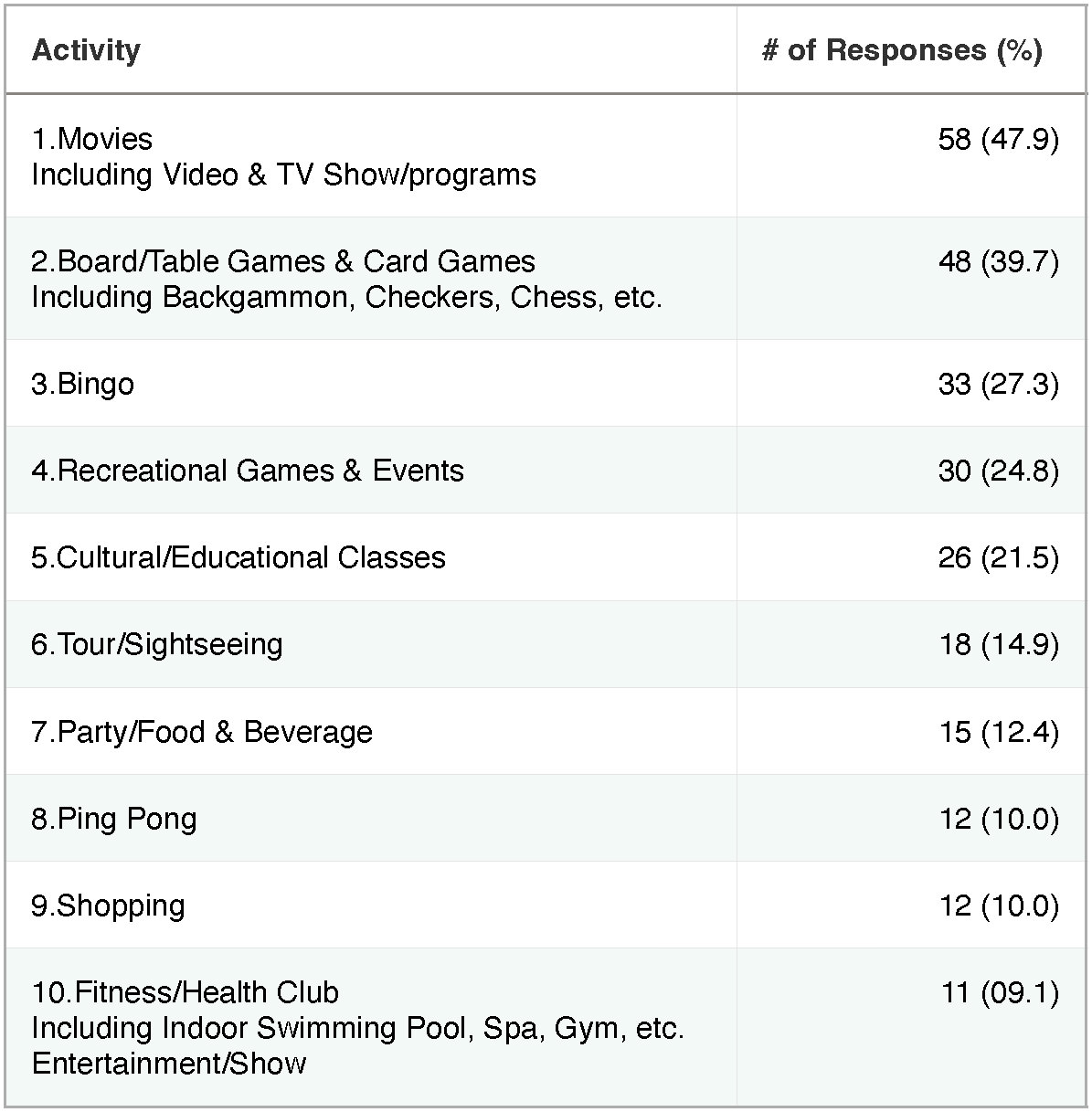
Appendix 3a
Caribbean’s Top 10 Common Rainy Day Activities
Total: 33 Responses
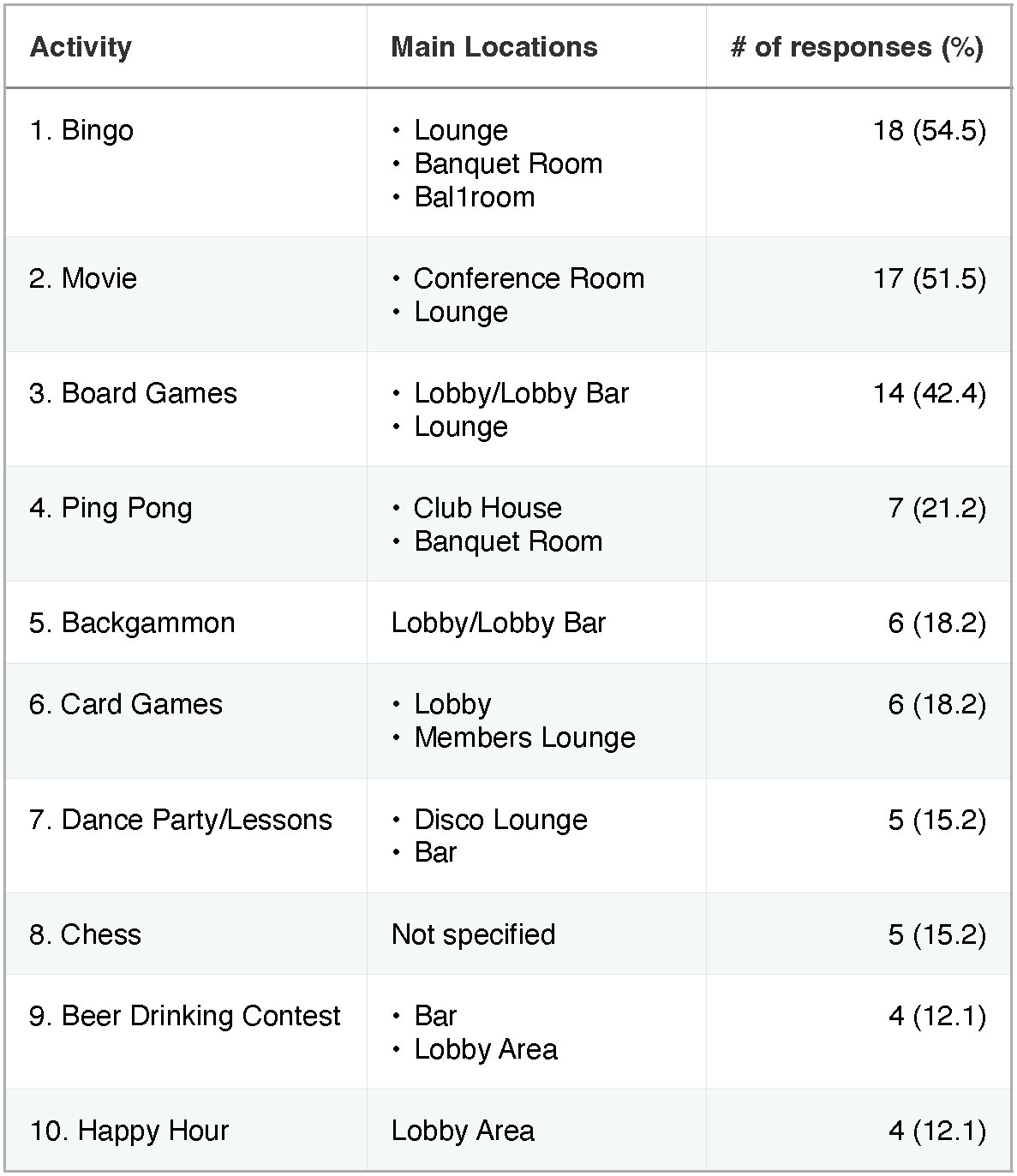
Appendix 3b
Hawaii’s Top 8 Common Rainy Day Activities
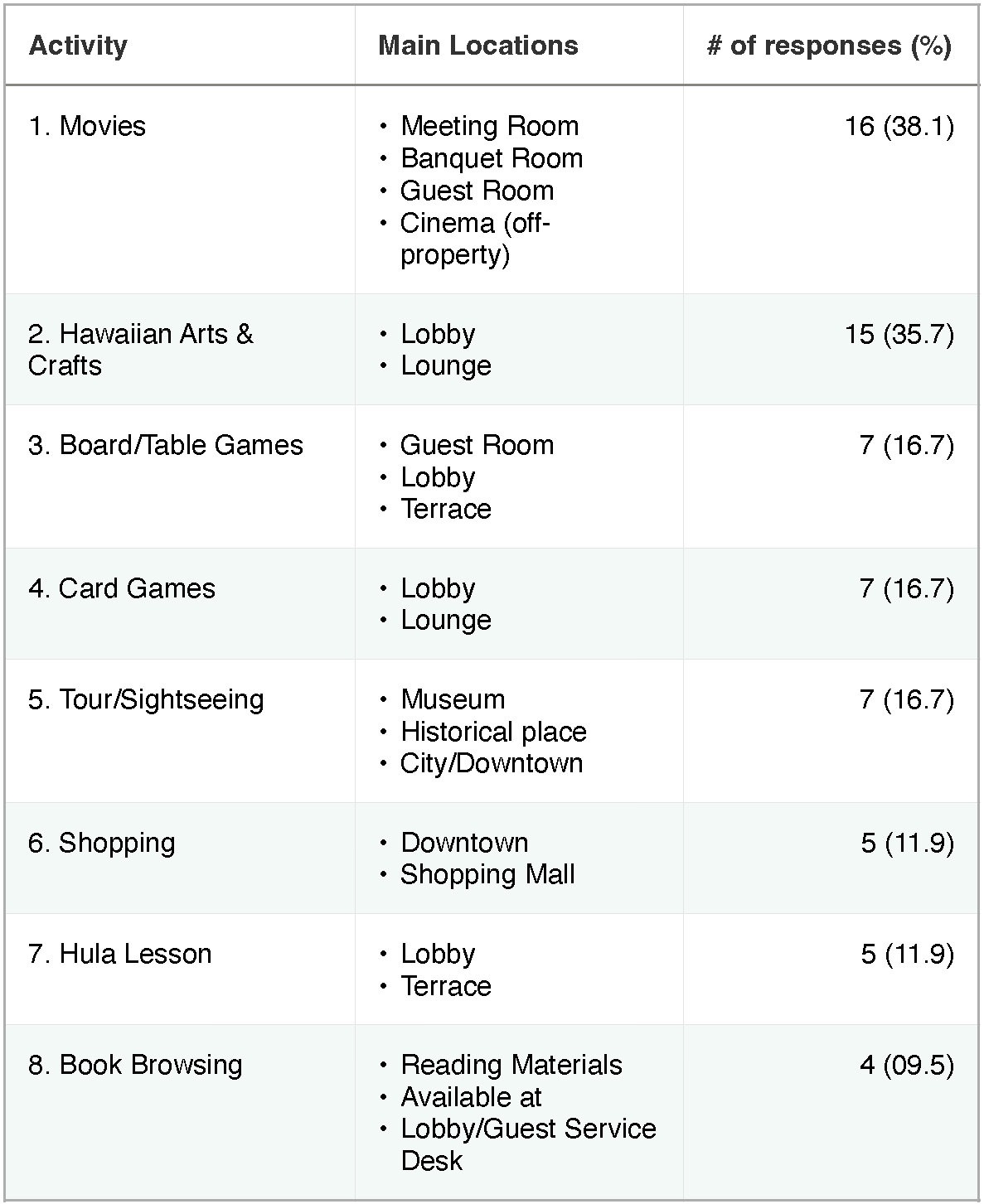
Appendix 3c
Florida’s Common Rainy Day Activities Florida
(Miami & Daytona Beach)
Total: 15 Responses
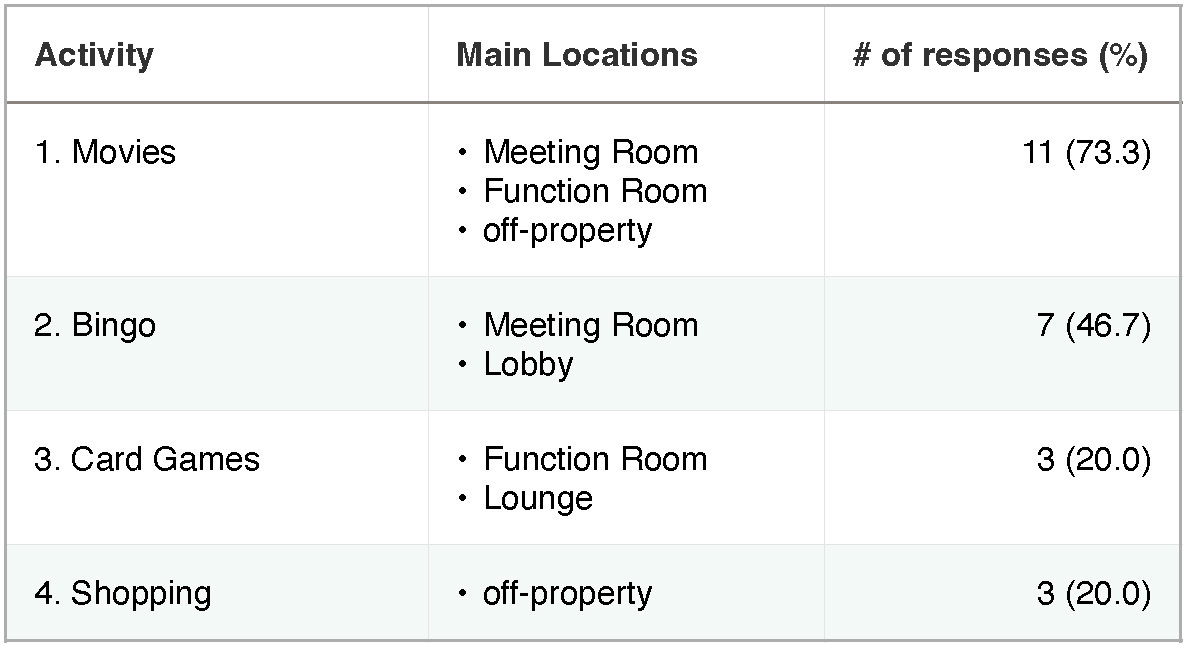
Appendix 3d
Southern California’s Common Rainy Day Activities Southern California
(Santa Monica, Marina Del Rey, & San Diego)
Total: 12 Responses
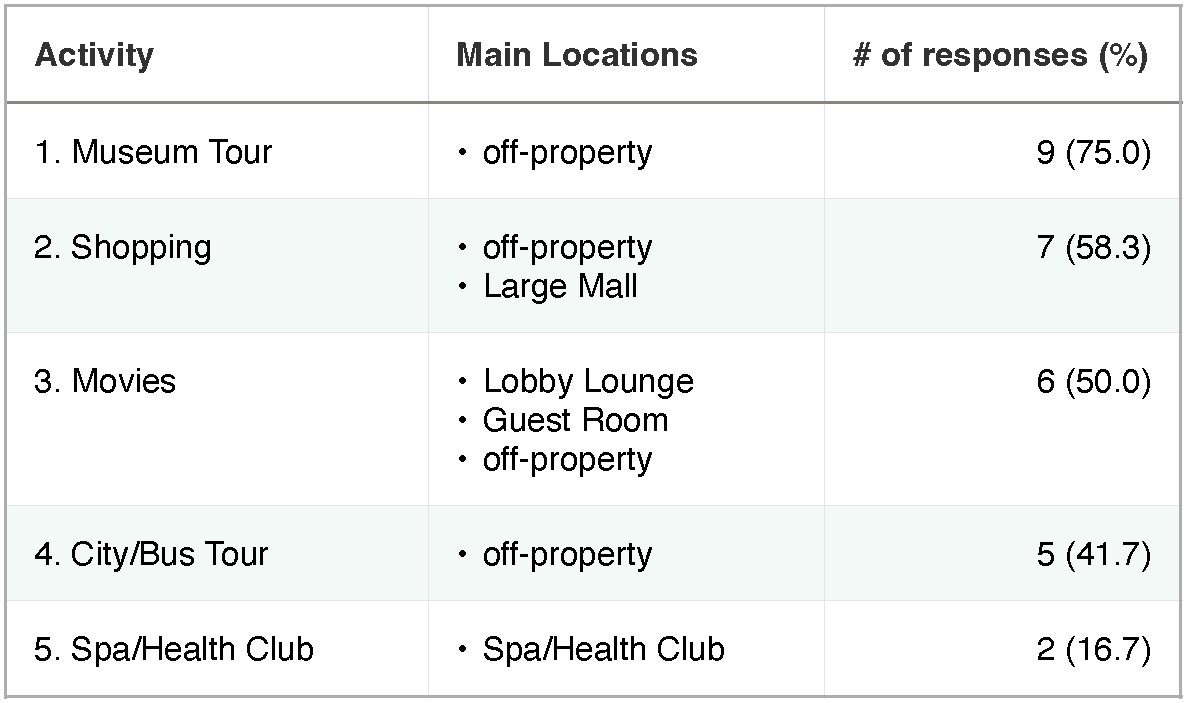
Appendix 3e
Mexico’s Common Rainy Day ActivitiesMexico
(Acapulco & Cancun)
Total: 10 Responses
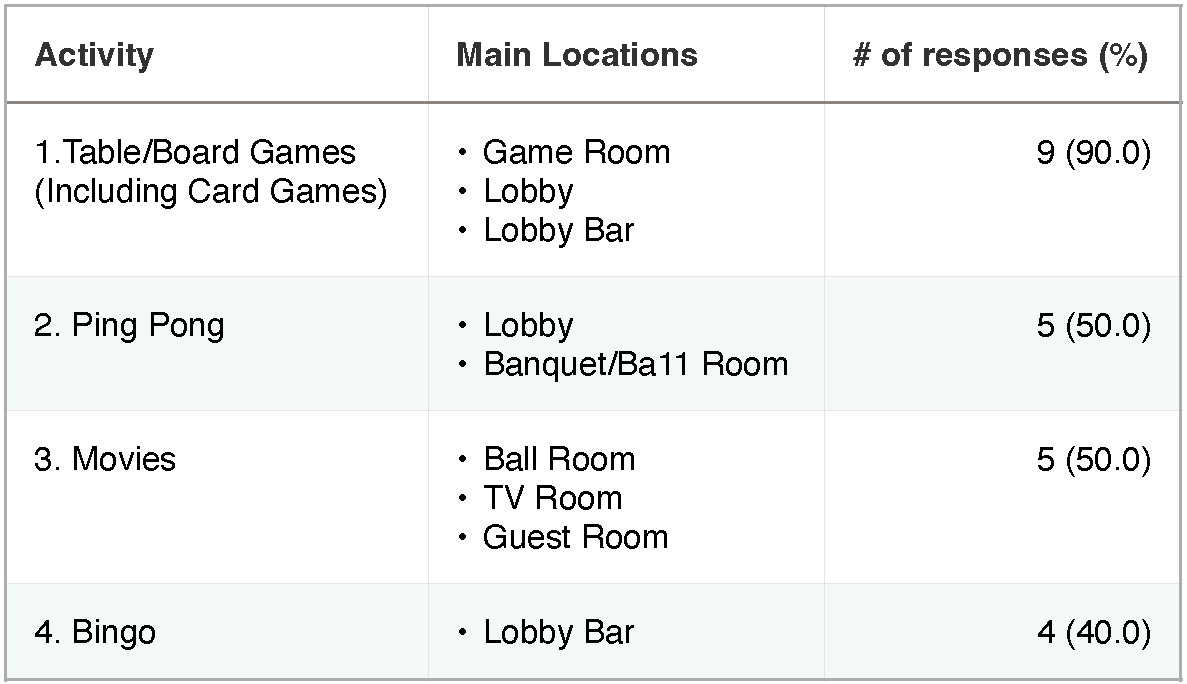
Appendix 4f
West Pacific Islands’ Common Rainy Day Activities west Pacific Islands
(Guam, Saipan & Okinawa)
Total: 9 Responses
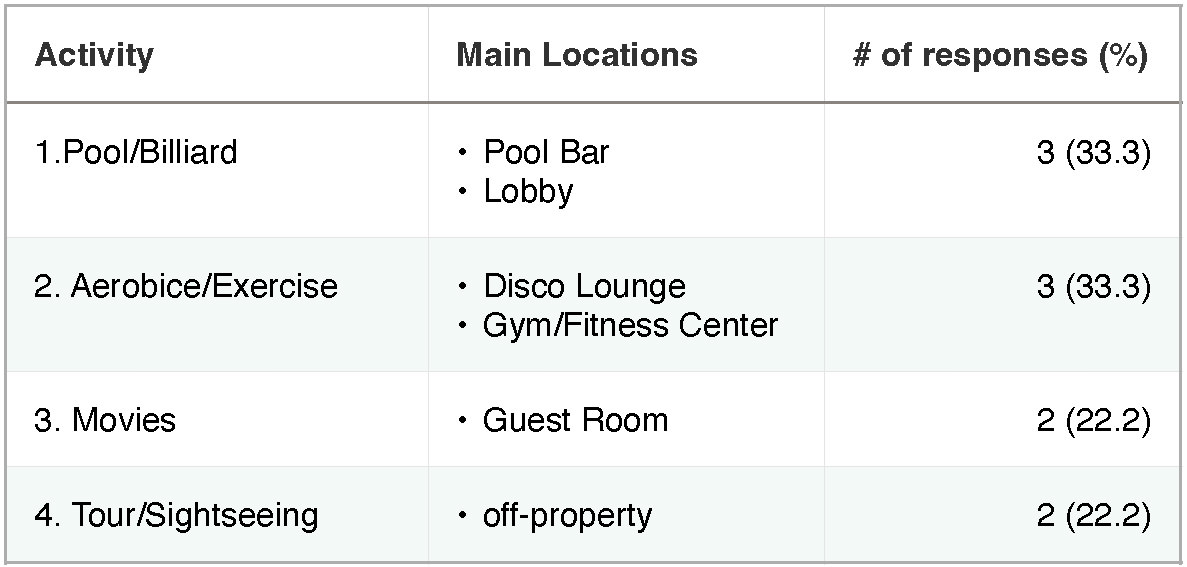
Appendix 4a
Detailed Rainy Day Activities (Caribbean)
Sports
Indoor/Specific
Ping Pong
Volleyball
Basketbal1
Aerobics
Gym/Weight training
Pool/Billiard
Darts
Indoor/General
Mini Olympics
Outdoor
Water volleyball in the rain
Non-hotel facility
Bowling
Entertainment
Shows
Music entertainment
Local artist/band
Steel band
Fashion show
Talent show
Movies
Film
Video
TV program
Sports event
Slide show
Games & Events
Recreational games & events
Games
Bingo
Musical chairs
Dominoes
Passing the orange
Dancing around the bottle
Musical statues
Charade
Pictionary
Shuffle board
Scavenger hunt
Events
Beer drinking contest
Wet & wild T-shirt competition
Hermit crab race
Mystery tune contest
Coloring contest
Limbo dance
Board/Table games
Cards
Bridge
Board games
Backgammon
Chess
Checkers
Video/Computer games
Nintendo
Cultural/Educational
Dance lesson and party
Reggae
Language class
Spanish
Cooking class
Local food
Oyster opening lessons
Napkin folding
Beverage class
Drink mixing lessons
Wine tasting
Party/Food & Beverage
Party
Cocktail party
Coffee/Tea party
Dinner party
Special F&B operation
Happy hours
F&B outlets (Extra hour operation)
Tour/Sightseeing
Hotel
Kitchen tour
Sightseeing tour
Downtown
Historical place
Shopping
Shopping mall
Others
Casino
Gambling lessons
Extra hour operation
Black coral & coin jewelry presentation
Appendix 4b
Detailed Rainy Day Activities (Hawaii)
Sports
Indoor
Ping Pong
Fitness/Exercise
Weight training
Health Spa
Putter Golf
Off-property
Bowling
Entertainment
Music entertainment
Live music show
Hawaiian music
Concert (off-property)
Movies
In-House
Film
Video
Cinema (off-property)
Other entertainment
Slide show
Bird show
Games & Events
Recreational games & events
Bingo
Board/Table games
Cards
Board games
Backgammon
Chess
Checkers
Video/Computer games
Cultural/Educational
Hawaiian culture demonstration and lessons
Arts & Crafts
Lei making
Lauhala weaving
Hawaiian basket weaving
Coconut leaf weaving
Hawaiian language class
Hula lesson
Ukulele lesson
Cooking demonstration and class
Beverage class
Wine tasting
Book browsing
Reading materials
Books & Periodicals
Party/Food & Beverage (F&B)
Party
Coffee & Tea party
Cocktail party
Buffet party
Special F&B operation
Happy hours
Karaoke bar
F&B outlets (Extra hour operation)
Tour/Sightseeing
Sightseeing tour
Historical tour
City/Downtown tour
Museum
Aquarium
Special tour
Submarine rides
River boat rides
Shopping
Others
People watching
Appendix 4c
Detailed Rainy Day Activities Florida (Miami Beach & Daytona Beach)
Sports
Indoor
Swimming Pool
Health Spa
Yoga
Chair Exercise
Mini Olympics
Entertainment
Movies
Film
Video
Cinema (off-property)
TV program
Games & Recreation
Recreational games
Bingo
Name that tune
Win, lose, or draw
Wheel of fortune
Scavenger hunt
Dominoes
Kids games
Board/Table games
Cards
Board games
Video/Electrical games
Horse racing game
Recreation
Sing-a-long
Line dancing
Party
Tour/Sightseeing
Shopping
Appendix 4d
Detailed Rainy Day Activities Southern California (Santa Monica, Marina Del Rey, & San Diego)
Sports
Indoor
Spa
Health club
Pool/Billiard
Entertainment
In-House
Movies
Film
Video
TV/video
Sports bar
Off -property
Cinema
Play/Musicals
Omnimax theater
Games
Board/Table games
Cards
Board games
Game room
Basketball game
Pinball
Golf simulator
Party/Food and Beverage
Happy hour
Sports bar
Tour/Sightseeing
Museum tour
City/Bus tour
Winery tour
Shopping
Large mall
Transportation service
Appendix 4e
Detailed Rainy Day Activities Mex1co (Acapulco & Cancun)
Sports
Ping Pong
Entertainment
Movies
Film
Video
TV/Video
Sports bar
Games
Recreational games
Bingo
Dominoes
Board/Table games
Cards
Chess
Backgammon
Board games
Video/Computer games
Cultura1/Educational
Arts & Craft
Spanish language lessons
Mexican cooking classes
Party/Food & Beverage
Happy hour
Cocktail party
Appendix 4f
Detailed Rainy Day Activities Western Pacific Islands (Guam, Saipan & Okinawa)
Sports
Indoor
Pool/Billiard
Ping pong
Aerobics
Gym/Exercise
Golf (Practice/Putting)
Swimming pool
Water sports
Indoor ski/skate
Entertainment
Movies
Film
Video
Cultural entertainment
Local show/music
TV program
Games & Events
Games
Board games
Video/Computer games
Other games
Casino simulation
Events
Party
Food & Beverage
“Carnival” party
Tour/Sightseeing
Appendix 5
Facilities & Equipment Desired for Rainy Day Programs
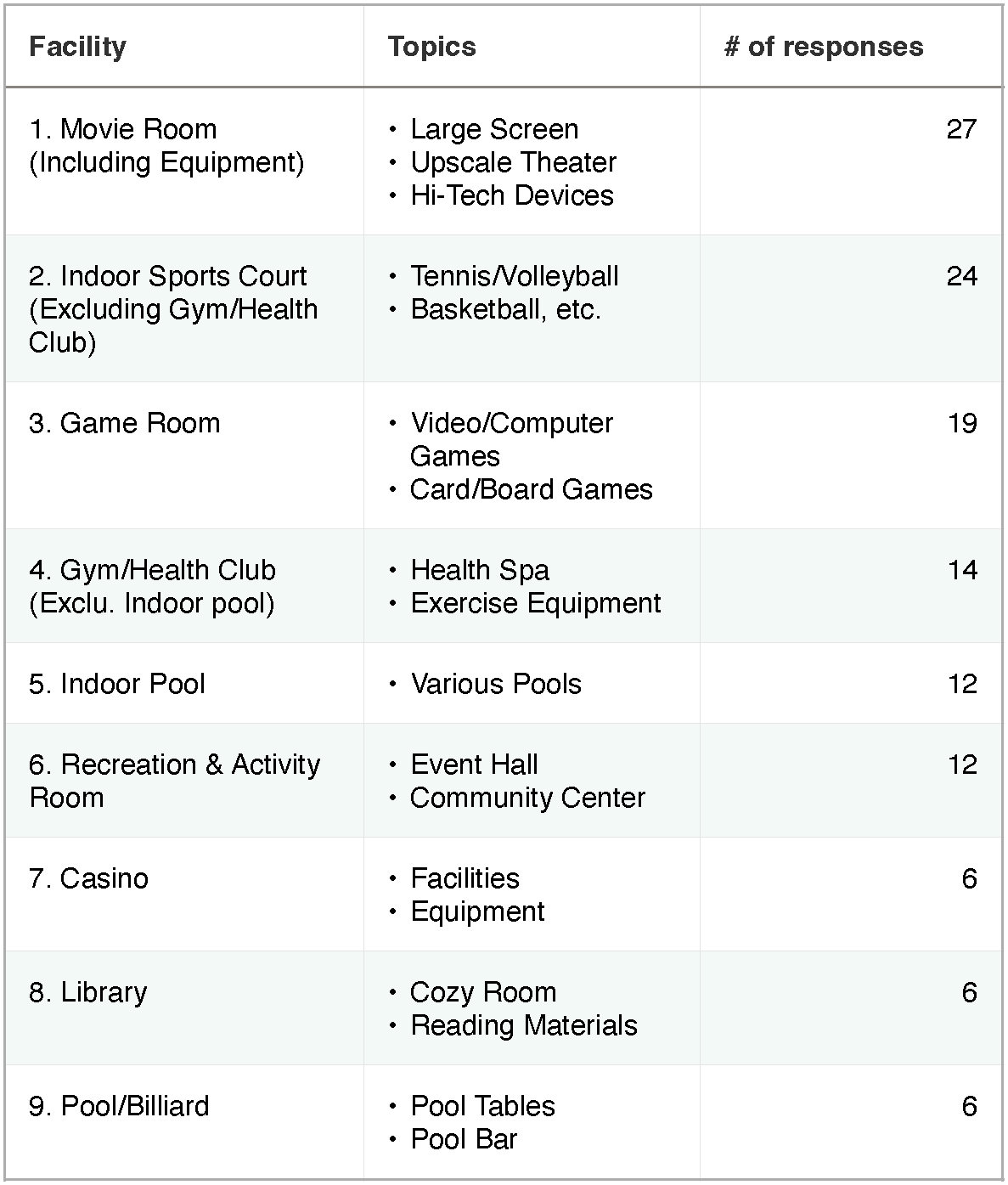
Appendix 6
Detailed Desired Rainy Day Activities
Sports
Indoor Sports
Tennis
Basketball
Volleyball
Handball
Squash/Racquetball
Soccer
Archery
Croquet
Badminton
Ice skating
Softball
Football
Horse riding
Gym/Health Club/Spa/Fitness Center/Kurhaus
Aerobics
Yoga
Exercise class
Exercise equipment
Sauna/Steam room
Tanning salon
Massage
Beauty treatment
Nautilus
Indoor Swimming Pool
Organized pool party & games
Water aerobics
Scuba diving
Indoor patio pool
Whirlpool
Other Sports
Miniature-golf course
Bowling
Pool/Billiard
Ping Pong
Darts
Electrical dart board
Mini Olympics
Entertainment
Live shows
Concert Hall
Music entertainment
Local band
Steel band
Concert
Theater/Entertainment Hall
Magic show
Talk show
Circus
Trapeze
Trampoline
Juggling
Clown show
Fashion show
Talent show
Dance show
Special dance hall
Reviews/Musicals
Limbo show
Movies
In-House/Film & Video
In-house (In-room) cinema
Huge cinema screen & projector
High-tech movie
Imax theater
All day program with refreshments
Free videos
Cinema (off-property)
Free tickets/Free transportation
TV/Video
VCR lounge with video library
Sports video
Sport boo-boos films
Cartoons
Slide show
Two way communication/entertainment
Guest playing musical shows
Karaoke
Children’s Center
Children’s activity/entertainment center
Children’s camp
Children’s games/toys inventory
Childcare/Nursery
Children’s counselor
Learning sessions
Arts & Crafts
Games & Events
Facilities & Equipment
Indoor recreational/activity center
Casino
Activity center
Game room
Electronic games (Horse racing game, etc.)
Poker table
Uniforms for rain
Luxury prizes
Professionals
Game & Event organizer
Coordinators
Recreational games & events
Games
Bingo (upgraded, ie, by VCR/TV)
Tic Tac Toe
Sing along
Treasure hunt
Musical chairs
Passing the orange
Dancing around the bottle
Musical statues
Charades
Pictionary
Shuffle board
Scavenger hunt
Dominoes
Trivia
Horse racing game
Win, lose, or draw
Canasta games
Carnival type games
Event, Competition, & Contest
Murder Mystery
Best “rainy day” photo contest
Crab race
Wet T-shirt contest
Mr. Sexy legs
Best wet hairdo
Mr. Muscle
Tarzan & Jane contest
Robinson Crusoe for a day
Beer drinking contest
Mystery tune contest
Coloring contest
Limbo dance
Hula Hoop contest
Dancing contest
Talent contest
Ring play
Board/Table/Card games – Tournament
Video/Computer games (Nintendo, Arcade, etc)
Cultura1/Educational
Facility
Community center
Seminars/Lectures
Special seminars (Health care, etc.)
Professional/Non-professional guest speakers
Marine biology lectures
Arts & Craft
Art/Painting classes
Jewelry making
Flower arrangement class
Shell craft
Dyeing fabrics
Pottery/Chinaware
Folk songs
Basket/Hat/Fabric weaving
Local Arts & Craft (Hawaiian, Mexican, etc.)
Cooking class
Cooking demonstrations – Chefs
Special/Local cooking classes
Dancing classes
Ballroom dance
Jazz dance
Language class (Local)
Make-up class
Beverage class
Drink mixing lessons
Wine tasting
Library
Reading materials
Novels
Periodicals
Party/Food & Beverage
Party
Cocktail party
With games and music/fashion show
With hors d’oeuvres
Coffee/Tea party
Theme luncheon party (Sock Hop, Tailgate, Cowboy, etc.)
Disco party
Special F&B operation
Happy hours/Complimentary drinks
Morning/Afternoon coffee & tea service
Sports bar
Tour/Sightseeing
Inside hotel tour
Kitchen/Front Desk/Maintenance/Housekeeping
Sightseeing tour – Historical/Downtown
Museum/1ibrary tour
Shopping
Shuttle service
Shopping advice/class
Organized shopping tour
In-house shopping mall (Boutique, F&B, etc.)
Others
Special facility
Amusement park
Survival game in the jungle
Artificial lake and submarine ride
Artificial reef to alleviate the rough surf
Ocean with roof
Huge dome roof
Special program
Discount (F&B, next visit, etc.)
Larger cabana
References
Hart, C.W.L. (1987). Service Guarantee; How good can you be?
Unpublished manuscript, Harvard Graduate School of Business Administration, Boston.
Lewis, R.C. (1984). Theoretical and practical consideration in research design. The Cornell Hotel and Restaurant Administration Quarterly. 24(4), 25-35.
Plummer, J.T. (1974). The concept and application of life style segmentation. Journal of Marketing, 38, 33-37.
Maister, D.H. (1985). The psychology of waiting lines. In J.A. Czepiel, M.R. Solomon, & C.F. Surprenant (Eds.) , The Service encounter (pp. 113-123) Washington D.C.: Hearth.
Levitt, T. (1964). Marketing myopia. In C.B. Bursk & J.F. Chapman (Eds.), Modern Market,ing Strategy (pp. 24-48). Cambridge, Mass: Harvard University Press.
Jones, C., & Decotiis. (1988). A better way to select service employees: Video-assisted testing. In C.H.
Lovelock (Ed.), Marketing Services Marketing, Operations, and Human Resources (pp. 310-317). New Jersey: Prentice Hall.
Norman, R. (1988). Getting people to grow. In C.H. Lovelock (Ed.), Marketing Services Marketing, Operations, and Human Resources(pp. 305-309). New Jersey: Prentice Hall.
Thompson, A.A., Jr., & Strickland III, A.J. (1989). Strategy formulation and implementation (4th ed.). (p.295). Boston: PBI/IRWIN.
Waterman, R.H., Jr. (1982). The seven elements of strategic fit. Journal of Business Strategy, 2(3), 70.
Hart, C.W., & Berger, F. (1984). The chief de village study. Unpublished manuscript, School of Hotel Administration, Cornell University, Ithaca, New York.
Hostage, G.M., (1975). Quality control in a service business. Harvard Business Review, 53(4), 98-106.
